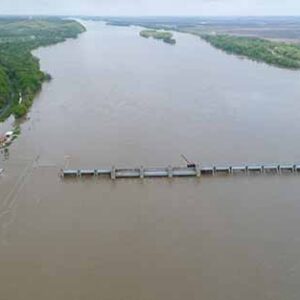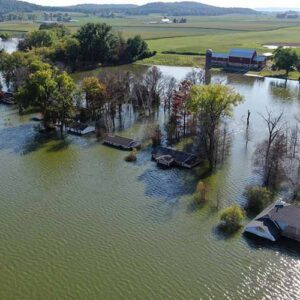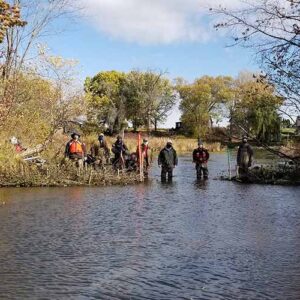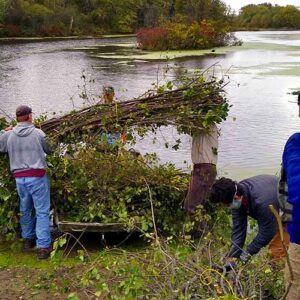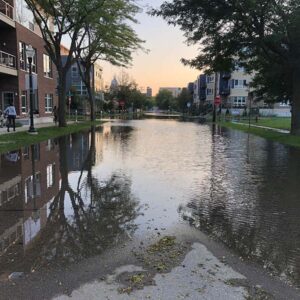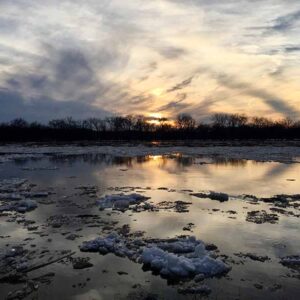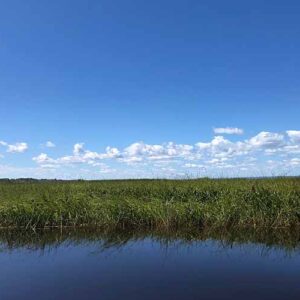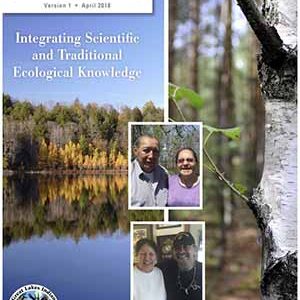The WICCI Water Working Group assesses and synthesizes climate change impacts to Wisconsin’s waters and develops adaptation strategies for dealing with those impacts.
Key Focus Areas

Lakes
Water temperatures on lakes are warming in concert with air temperatures. Ice cover duration is shorter, surface waters are warmer in spring and fall, and warm summers occur more frequently, but maximum summer surface temperatures are not increasing. Bottom temperatures are warming in some lakes and cooling in others. Stratification is stronger and occurs for a longer period of time.
Explore

Rivers
Wetter conditions overall are likely driving increased streamflows. Annual streamflow increased across Wisconsin with the largest increases in the south in the past 30 years (1991–2020). Peak streamflows increased in the Driftless Area and in southeastern Wisconsin during the same time frame. In central and northern Wisconsin, peak streamflows increased on some streams and decreased in others. Not only will changing streamflow alter channel morphology, but changing historic streamflows can also lead to incorrect estimates of flood magnitude and frequency, which are used for floodplain management, road, and bridge construction.
Explore
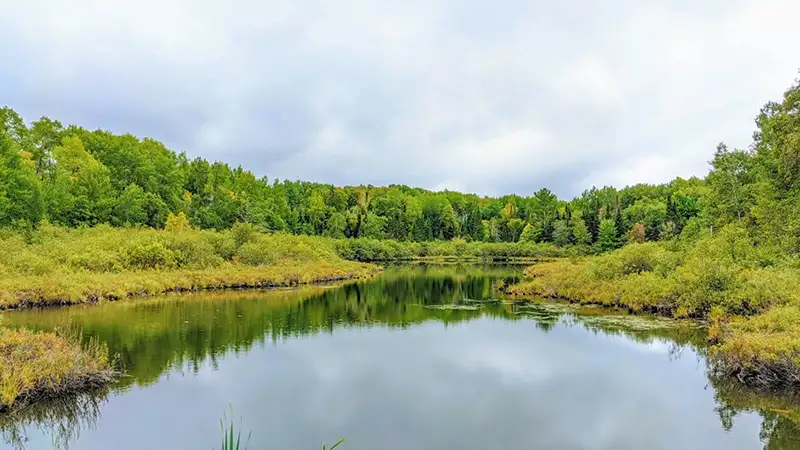
Watersheds
Restoration and protection are critical for climate resilience. Restoring and protecting Wisconsin’s waters requires action at the watershed scale. Restoration plans and assessments, such as Total Maximum Daily Load analyses, are being conducted with consideration for future climate conditions rather than relying solely on data from the past. At the same time, protecting waterbodies and watersheds that are already healthy builds resilience to the impacts of climate change, such as extreme precipitation. As of 2022, Wisconsin now has a statewide water resources protection framework, The Wonderful Waters of Wisconsin, that creates a road map for prioritizing the protection of these Healthy Watersheds and High-Quality Waters.
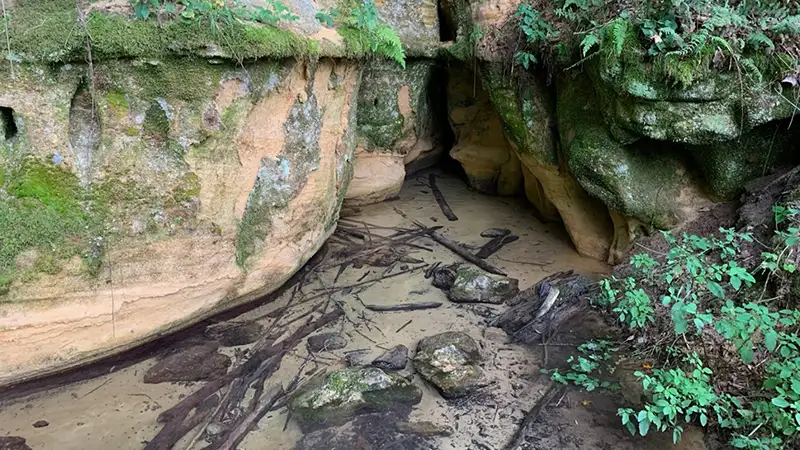
Groundwater
Groundwater levels are varying more than ever — and more quickly than ever. Across parts of the state, groundwater has gone from extreme lows to extreme highs, back to extreme lows, often in less than a decade. This is driven by changes in precipitation, and results in dry streams and lakes turning into flooded fields and flooded basements. Groundwater is often considered a sustainable buffer against climate change impacts by providing a constant source of clean, cool groundwater for drinking, trout refugia, industrial use, and wetland habitat. But groundwater is still affected by climate change — including increased temperatures, increased precipitation, and increased precipitation variability — but its response time is slower than other parts of the water cycle.
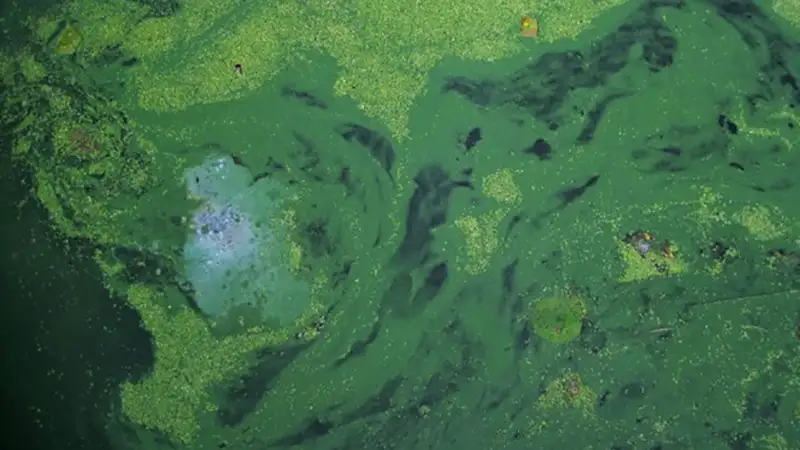
Harmful Algal Blooms
Harmful algal blooms are increasingly promoted by ongoing year-round changes to Wisconsin’s climate, including in lakes where they have not been a problem in the past. Of particular concern are cyanobacterial blooms (often referred to as blue-green algae), which can produce toxins that can cause illnesses in humans and animals. Warmer water temperatures are more hospitable for algae growth, and can lead to stronger summer stratification, which can cause some lakes to release phosphorus from lake sediments. Intensifying rain events bring more runoff and associated nutrients into lakes and rivers, fertilizing bloom growth. Longer growing seasons allow algae populations to persist into autumn and winter and short ice duration allows them to begin growth earlier in the spring.
If you are interested in working with us on water projects in your region, reach out to one of our working group cochairs!
Summary of Issues and Impacts
Rising air temperatures, more precipitation from fall to spring, and more frequent and larger extreme precipitation events affect Wisconsin’s lakes, streams, groundwater and wetlands.
Warmer Water Temperatures Impact Water Quality, Aquatic Life, and Culture
Warmer water has several impacts. These include the loss of winter recreational opportunities on ice, increased risk of winter drownings, reduced dissolved oxygen, reduced cold-water habitat for fish, increased release of phosphorus from lake sediments, more harmful algal blooms, shifts in fish populations towards warm water species, and alters the suitability for aquatic invasive species.
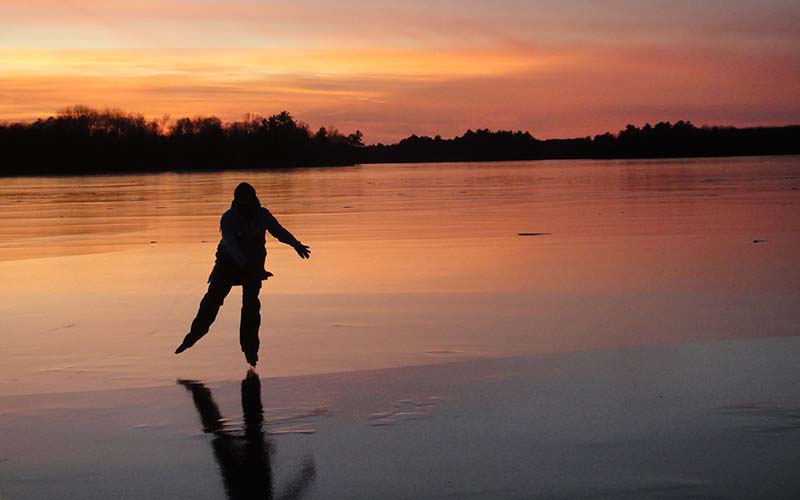
Changing Precipitation Patterns and Evapotranspiration Affect Water Levels
Groundwater and lake levels often go up and down on an approximate decadal cycle. Lows occur after an accumulation of years with low precipitation and highs after many years of above-average precipitation. Changing precipitation patterns with changing temperatures could shift the balance between precipitation and evaporation, causing water levels to fluctuate at higher or lower levels than they have in the past. Greater climatic extremes may also cause water levels to fluctuate more dramatically.
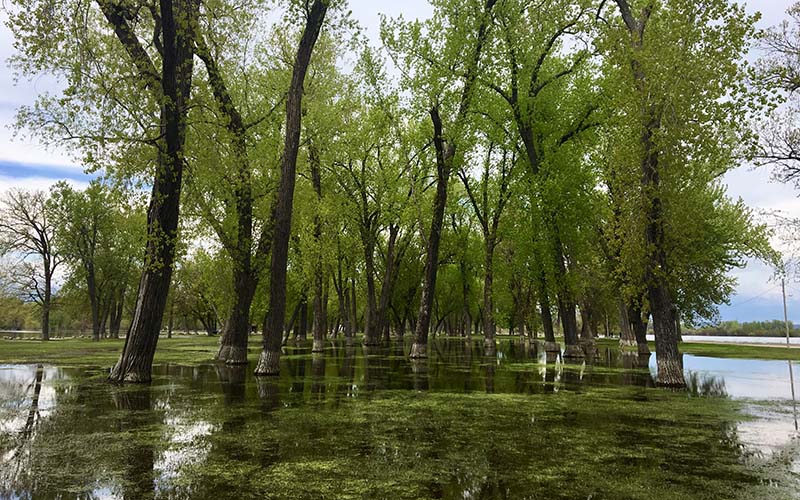
More Extreme Precipitation Results in Flooding, Water Quality, and Health Problems
Groundwater, stream, and lake flooding pose risks to human health by compromising septic and sewage systems and contaminating drinking wells. Floods also increase contaminant transport, harm infrastructure and shoreland vegetation, increase erosion and runoff, and reduce water quality. Pumping or diverting water from one waterbody to another to alleviate flooding enhances the risk of spreading aquatic invasive species.
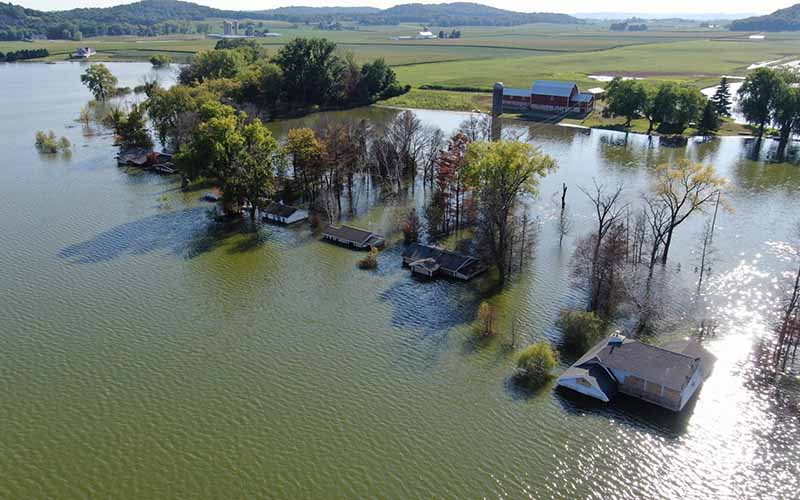
Drought Impacts Water Quantity and Quality
Despite overall increases in precipitation, drought remains a threat due to rising temperatures. Longer growing seasons increase the amount of water lost to the air through evapotranspiration, leaving less moisture to soak into the ground and recharge groundwater supplies. Drought also reduces the volume of surface water, sometimes drying up drinking water wells and water bodies completely. The overall loss of volume and reduced inflow of cooler groundwater during a drought can warm surface waters, which can impact water quality and decrease dissolved oxygen in some surface waters.
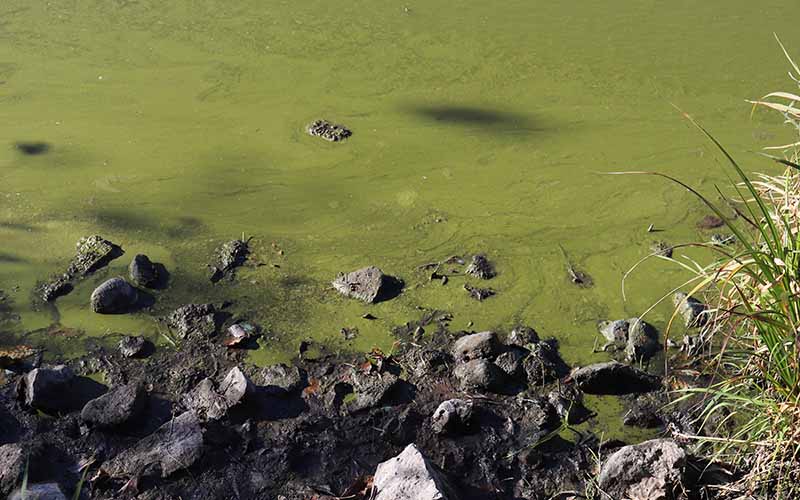
Recommended Solutions/Strategies
1. We can no longer use the past to plan for the future.
Instead, we should design strategies that will succeed in a warmer and wetter climate. For example, replace culverts blown out during large storms with larger ones that can withstand bigger storms.
2. Adapting to climate change means employing existing tools more urgently at greater scales.
For example, more extreme rainfall results in even more runoff and nutrient pollution in surface waters. Practices that promote infiltration and reduce runoff must be even more extensive to attain water quality goals.
3. Solutions are not one size fits all.
The unique characteristics, challenges, and goals of each location call for tailored adaptation strategies that are place-based and selected based on the specific resilience objectives. For example, successful solutions will be different in agricultural versus forested watersheds.
4. Investing in climate resilience today saves resources in the long run.
For example, upscaling culverts for bigger storms requires a greater initial capital investment but will often be cheaper than frequently replacing a small culvert. Investing in practices that improve water quality will prevent lost revenue and generate economic opportunity through higher real estate values, tourism, and related economic activity.
The Resist Accept Direct (RAD) Framework helps users identify attainable solutions. For more on this framework, see the Fisheries and Great Lakes working group webpages.
Click through the following categories for a selection of adaptation strategies for water, as well as some relevant resources and examples. For additional strategies, see Scientific Advances and Adaptation Strategies for Wisconsin Lakes Facing Climate Change and USDA’s Climate Adaptation Menus.
This is an accordion element with a series of buttons that open and close related content panels.
Education
Provide ice safety advisories to warn of changing ice conditions.
Prevent the spread of Aquatic Invasive Species by inspecting and cleaning boats at public launches.
Provide public advisories on how to recognize a harmful algal bloom that could pose a threat to human and pet health.
Conservation
Protect the area along lake shorelines to be more resilient to fluctuating water levels.
- Resource: Healthy Lakes and Rivers
Employ agricultural best management practices (e.g., perennial grasslands for grazing and cover crops) to reduce erosion and nutrient runoff.
- Resources: WICCI Agriculture Working Group, Wisconsin Land + Water
Protect and restore wetlands to be more resilient to extreme rain events.
- Resource: Wetlands by Design
- Example: Restoring Wetlands in the Mukwonago River Watershed
Engineering
Use floating or rolling piers that can go up and down with lake level fluctuations.
Re-evaluate dam infrastructure and water level orders for future climate and consider dam removals or replacements where necessary.
Build green infrastructure in urban environments to reduce runoff and minimize flooding.
- Resource: Fresh Coast Guardians Resource Center
- Examples:
Build electric fish barriers to prevent the spread of invasive species.
Inventory culverts to prioritize those that need to be replaced and upsized.
- Resource: Great Lakes Stream Crossing Inventory Method
- Example: Vilas County Stream Crossing Inventory
Properly size and install flood resilient culverts.
Policies
Support and/or develop zoning regulations that protect the riparian zone from development.
Improve stormwater regulations and enforce management practices that reduce runoff and nutrients in urban areas.
Use future rainfall and streamflow statistics to develop nutrient reduction plans for waters impaired by high phosphorus concentrations.
Support and/or develop regulations that limit ways for aquatic invasive species to spread.
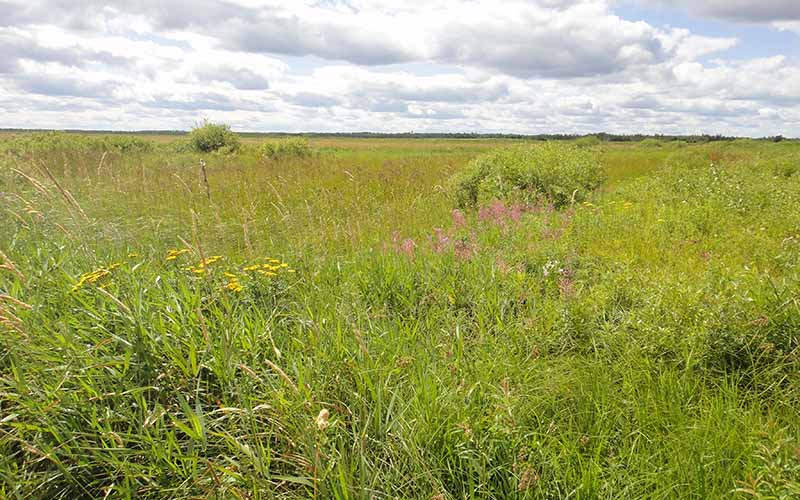

Environmental and Climate Justice Issues
Flood Risk
Increased precipitation and extreme rain events flood homes, septic, and sewage systems and contaminate drinking water, impacting human health and financial well-being. Families in flood-prone areas who do not have the financial resources to mitigate or recover quickly from these events are especially at risk. Planned buyouts offer a solution: they purchase private lands at risk of flooding and put them to public use, providing both financial and health protection from future floods. The new public lands can also increase equitable access to recreational opportunities along lakes and waterways.
Groundwater Risk
During periods of low groundwater levels, shallow drinking wells may become partially or completely dried, impacting water quality and damaging the well systems themselves. Those living in regions with vulnerable groundwater reserves and lacking the financial resources to respond will be disproportionately impacted by these climate change effects.
Food Security Risk
Lake warming, longer growing seasons, and increased runoff from intensifying rainfall promotes the growth of harmful algal blooms. People of all socioeconomic classes enjoy fishing for both sport and nutrition. Harmful algal blooms can degrade aquatic environments and potentially produce toxins that affect human and wildlife health.
Recurring intense blooms lead people to avoid fishing and fish consumption due to water conditions and actual or perceived risks of toxins in fish. Some cyanobacteria produce nontoxic taste and odor compounds that contribute off-flavors to fish flesh, which may lead to further avoidance of fishing and fish consumption. Avoiding affordable, locally caught fish could adversely affect some people’s daily dietary needs.
Resources
This is an accordion element with a series of buttons that open and close related content panels.
Fact Sheets
Reports and Findings
The following resources from the Water Working Group summarize the latest information regarding the impacts of warming and changing precipitation patterns and offer a wide variety of adaptation strategies. We also encourage readers to revisit the 2021 and 2011 (pdf) WICCI assessment reports for a comprehensive review of climate change impacts to water.
- Impacts of and Adaptation Strategies for Climate Change on Wisconsin’s Water Resources (pdf) (2020 Water Resources White Paper)
- 2020 Climate Adaptation Strategies for Wisconsin’s Water Resources (pdf) (developed for WICCI Report to the Governor’s Task Force on Climate Change)
- Long-term epilimnetic temperature trends in Lake Mendota and Trout Lake, Wisconsin (pdf)
- Response in the water level of Anvil Lake, Wisconsin, to changes in meteorological and climatic conditions (pdf)
- Mississippi River Climate Change: Status, Challenges and Adaptations (pdf)
Data and Tools
- Wisconsin Land + Water Climate Resilience Toolkit
- EPA Resilience Resource Directory
- EPA Climate Change Indicators: Ecosystems
- EPA Green Infrastructure for Climate Resiliency
- Midwest Glacial Lakes Partnership Conservation Planner
- National Oceanic and Atmospheric Administration: Climate at a Glance
- USGS Process-based predictions of lake water temperature in the Midwest U.S.
- Wetlands by Design
- Wisconsin Rainfall Project
- Wisconsin State Climatology Office
- Wisconsin Water Explorer (WEx)
- Wonderful Waters of Wisconsin (Healthy Watersheds, High-Quality Waters)
Climate Assessments
- Development of a Climate Change Vulnerability Map for Bodies of Water in the Midwestern U.S.
- Flood Resilience in the Coon Creek Watershed
- Monroe County Climate Readiness and Rural Economic Opportunity Assessment, 2022 (pdf)
- Potential Effects of Climate Change on Stream Temperature in the Marengo River Headwaters
- Water-Quality Indicators of Human Impacts to the Wetlands of Door County, Wisconsin
Plans
These examples consider climate resilience and adaptation in a variety of land and water planning scales and contexts, demonstrating different approaches that various organizations have taken towards adaptation planning in Wisconsin.
Webinars
- EPA Tools and Resources Webinar Series
- Midwest Climate Adaptation Science Center: Science Seminar Series
- National Adaptation Forum: Moving Towards Preparedness for Extreme Weather Events Webinar Series
- Wisconsin Land and Water Climate and Conservation Webinar Series: Water Resources Climate Impacts and Adaptation Strategies
Funding
Our Team
Co-chairs
- Tim Asplund, Water Quality Bureau, Wisconsin Department of Natural Resources, Tim.Asplund@wisconsin.gov
- Katie Hein, University of Wisconsin–Madison Trout Lake Station, CHein@wisc.edu
- Aaron Pruitt, Bureau of Drinking and Groundwater, Wisconsin Department of Natural Resources, Aaron.Pruitt@wisconsin.gov
- Helena Tiedmann, Water Quality Bureau, Wisconsin Department of Natural Resources, Helena.Tiedmann1@wisconsin.gov
Members
- Christina Anderson, Wisconsin Land & Water
- Scott Butler, Professor Emeritus
- Steve Elmore, Wisconsin Department of Natural Resources
- Chris Ester, USDA, Forest Service, Chequamegon-Nicolet National Forest
- Shawn Giblin, Wisconsin Department of Natural Resources
- MaryJo Gingras, Ashland County
- David Hart, Wisconsin Geological and Natural History Survey
- Maureen Kalscheur, Wisconsin Department of Natural Resources
- Kevin Kirsch, Wisconsin Department of Natural Resources
- Gina LaLiberte, Wisconsin Department of Natural Resources
- Dick Lathrop, University of Wisconsin–Madison
- Peter Levi, The Nature Conservancy
- Madeline Magee, Wisconsin Department of Natural Resources
- Ezra Meyer, Wisconsin Department of Natural Resources
- Eric Olson, University of Wisconsin–Madison Division of Extension
- Nancy Turyk, Wisconsin’s Green Fire


